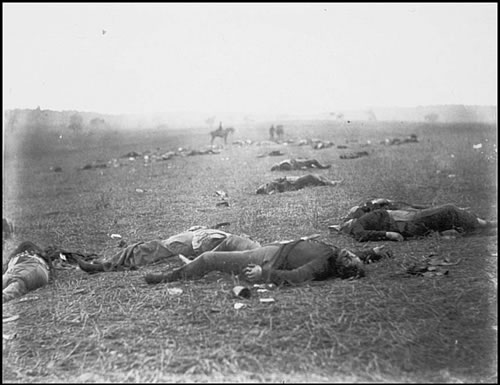I'm a sucker for anything numbered 13, which happens to be my favorite number and the number I wore on most of my soccer jerseys.
Check out the other ten.13 Photographs That Changed the World
Any picture can speak 1,000 words, but only a select few say something poignant enough to galvanize an entire society. The following photographs screamed so loudly that the entire world stopped to take notice.1. The Photograph That Raised the Photojournalistic Stakes:
"Omaha Beach, Normandy, France"
Robert Capa, 1944
"If your pictures aren’t good enough," war photographer Robert Capa used to say, "you aren’t close enough." Words to die by, yes, but the man knew of what he spoke. After all, his most memorable shots were taken on the morning of D-Day, June 6, 1944, when he landed alongside the first waves of infantry at Omaha Beach.
Caught under heavy fire, Capa dove for what little cover he could find, then shot all the film in his camera, and got out - just barely. He escaped with his life, but not much else. Of the four rolls of film Capa took of the horrific D-Day battle, all but 11 exposures were ruined by an overeager lab assistant, who melted the film in his rush to develop it. (He was trying to meet the deadline for the next issue of Life magazine.)
In an ironic twist, however, that same mistake gave the few surviving exposures their famously surreal look ("slightly out of focus," Life incorrectly explained upon printing them). More than 50 years later, director Steven Spielberg would go to great lengths to reproduce the look of that "error" for his harrowing D-Day landing sequence in "Saving Private Ryan," even stripping the coating from his camera lenses to echo Capa’s notorious shots.
2. The Photograph That Gave a Face to the Great Depression
"Migrant Mother"
Dorothea Lange, 1936
As era-defining photographs go, "Migrant Mother" pretty much takes the cake. For many, Florence Owens Thompson is the face of the Great Depression, thanks to legendary shutterbug Dorothea Lange. Lange captured the image while visiting a dusty California pea-pickers’ camp in February 1936, and in doing so, captured the resilience of a proud nation facing desperate times.
Unbelievably, Thompson’s story is as compelling as her portrait. Just 32 years old when Lange approached her ("as if drawn by a magnet," Lange said). Thompson was a mother of seven who’d lost her husband to tuberculosis. Stranded at a migratory labor farm in Nipomo, Calif. her family sustained themselves on birds killed by her kids and vegetables taken from a nearby field - as meager a living as any earned by the other 2,500 workers there. The photo’s impact was staggering. Reproduced in newspapers everywhere, Thompson’s haunted face triggered an immediate public outcry, quickly prompting politicos from the federal Resettlement Administration to send food and supplies. Sadly, however, Thompson and her family had already moved on, receiving nary a wedge of government cheese for their high-profile misery. In fact, no one knew the identity of the photographed woman until Thompson revealed herself years later in a 1976 newspaper article.
3. The Photograph That Brought the Battlefield Home
"Federal Dead on the Field of Battle of First Day, Gettysburg, Pennsylvania"
Mathew Brady, 1863
As one of the world’s first war photographers, Mathew Brady didn’t start
out having as action-packed a career as you might think. A successful daguerreotypist and a distinguished gentleman, Brady was known for his portraits of notable people such as Abraham Lincoln and Robert E. Lee. In other words, he was hardly a photojournalist in the trenches.In fact, Brady had everything to lose by making a career move - his money, his business, and quite possibly his life. Nevertheless, he decided to risk it all and follow the Union Army into battle with his camera, saying, "A spirit in my feet said, ‘Go!’" And go he did - at least until he got a good look at the pointy end of a Confederate bayonet.
After narrowly escaping capture at the first Battle of Bull Run, Brady’s chatty feet quieted down a bit, and he began sending assistants in his place. In the span of only a few years, Brady and his team shot more than 7,000 photographs - an astounding number when you consider that developing a single plate required a horse-drawn-wagon-full of cumbersome equipment and noxious chemicals. Not exactly what you’d call "point-and-shoot."
Tethered as he was to his equine-powered darkroom and with film speeds being much slower then, Brady produced war photos that are understandably light on the action and heavy on the aftermath. Still, they mark the first time Americans were so immediately confronted with the grim realities of the battlefield.



Thanks for having interesting links. Love the blog
ReplyDeleteI think you may have miss-attributed the Brady photograph. I believe the one you have linked it Timothy H. O'Sullivan's - "The Harvest of Death": Union dead on the battlefield at Gettysburg, Pennsylvania, photographed July 5–6, 1863
ReplyDeleteor else (possible) Wikipedia is incorrect. http://en.wikipedia.org/wiki/Timothy_H._O%27Sullivan
I recently came accross your blog and have been reading along. I thought I would leave my first comment. I dont know what to say except that I have enjoyed reading. Nice blog. I will keep visiting this blog very often.
ReplyDeleteMartha
http://smallpet.info